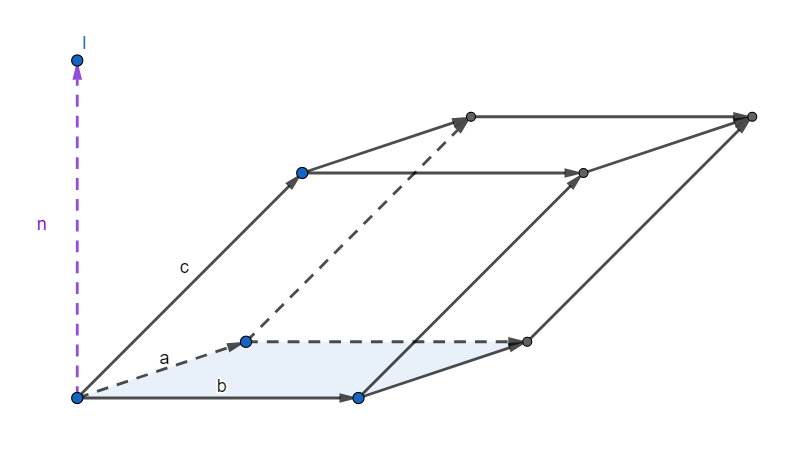
Answer
467.1k+ views
Hint: Use the fact that the area of the parallelogram whose adjacent sides are given by the vectors $\vec{a}$ and $\vec{b}$ is given by $A=\left| \vec{a}\times \vec{b} \right|$. Hence find the area of the base of the parallelepiped. Use the fact that the volume of a parallelepiped with area of base A and height H is given by $V=AH$. Hence determine the volume of the parallelepiped. Alternatively, use the fact that the volume of a parallelepiped with coterminous edges as $\vec{a},\vec{b},\vec{c}$ is given by $V=\left[ \vec{a},\vec{b},\vec{c} \right]$, we have $\left[ \vec{a},\vec{b},\vec{c} \right]$is the scalar triple product of the vectors $\vec{a},\vec{b}$ and $\vec{c}$.
Complete step by step answer:

Here $\vec{a}=2\hat{i}+3\hat{j}-4\hat{k},\vec{b}=5\hat{i}+7\hat{j}+5\hat{k}$ and $\vec{c}=4\hat{i}+4\hat{j}-2\hat{k}$
We know that the area of the parallelogram whose adjacent sides are given by the vectors $\vec{a}$ and $\vec{b}$ is given by $A=\left| \vec{a}\times \vec{b} \right|$.
Hence the area of the base of the parallelepiped is given by
\[\begin{align}
& A=\left| \left( 2\hat{i}+3\hat{j}-4\hat{k} \right)\times \left( 5\hat{i}+7\hat{j}+5\hat{k} \right) \right| \\
& =\left| 14\hat{k}-10\hat{j}-15\hat{k}+15\hat{i}-20\hat{j}+28\hat{i} \right| \\
& =\left| 43\hat{i}-30\hat{j}-\hat{k} \right|=\sqrt{{{43}^{2}}+{{30}^{2}}+{{1}^{2}}}=5\sqrt{110} \\
\end{align}\]
Also, the height of the parallelepiped is the projection of $\vec{c}$ on the normal vector of the base of the parallelogram. Note that the normal of the base is the vector $\vec{a}\times \vec{b}$ which as calculated above is given by $\vec{n}=43\hat{i}-30\hat{j}-\hat{k}$
We know that the projection of $\vec{a}$ on $\vec{b}$ is given by $\vec{p}=\dfrac{\vec{a}\cdot \vec{b}}{\left| {\vec{b}} \right|}\hat{b}$
Hence the height of the parallelepiped is given by
$H=\dfrac{\left( 4\hat{i}+4\hat{j}-2\hat{k} \right)\cdot \left( 43\hat{i}-30\hat{j}-\hat{k} \right)}{\sqrt{{{43}^{2}}+{{30}^{2}}+{{1}^{2}}}}=\dfrac{54}{5\sqrt{110}}$
Hence the volume of the parallelepiped is given by
$V=5\sqrt{110}\times \dfrac{54}{5\sqrt{110}}=54$cubic units.
Hence the volume of the parallelepiped is 54 cubic units.
Note: Alternative Solution:
We know that the volume of a parallelepiped with coterminous edges as $\vec{a},\vec{b},\vec{c}$ is given by $V=\left[ \vec{a},\vec{b},\vec{c} \right]$, we have $\left[ \vec{a},\vec{b},\vec{c} \right]$is the scalar triple product of the vectors $\vec{a},\vec{b}$ and $\vec{c}$.
We know that if $\vec{a}={{a}_{1}}\hat{i}+{{a}_{2}}\hat{j}+{{a}_{3}}\hat{k},\vec{b}={{b}_{1}}\hat{i}+{{b}_{2}}\hat{j}+{{b}_{3}}\hat{k},\vec{c}={{c}_{1}}\hat{i}+{{c}_{2}}\hat{j}+{{c}_{3}}\hat{k}$ then
$\left[ \vec{a},\vec{b},\vec{c} \right]=\left| \begin{matrix}
{{a}_{1}} & {{a}_{2}} & {{a}_{3}} \\
{{b}_{1}} & {{b}_{2}} & {{b}_{3}} \\
{{c}_{1}} & {{c}_{2}} & {{c}_{3}} \\
\end{matrix} \right|$
Hence, we have
$\begin{align}
& V=\left| \begin{matrix}
2 & 3 & -4 \\
5 & 7 & 5 \\
4 & 4 & -2 \\
\end{matrix} \right|=\left| 2\left( -14-20 \right)-3\left( -10-20 \right)-4\left( 20-28 \right) \right| \\
& =-68+90+32=54 \\
\end{align}$
Which is the same as obtained above.
Complete step by step answer:

Here $\vec{a}=2\hat{i}+3\hat{j}-4\hat{k},\vec{b}=5\hat{i}+7\hat{j}+5\hat{k}$ and $\vec{c}=4\hat{i}+4\hat{j}-2\hat{k}$
We know that the area of the parallelogram whose adjacent sides are given by the vectors $\vec{a}$ and $\vec{b}$ is given by $A=\left| \vec{a}\times \vec{b} \right|$.
Hence the area of the base of the parallelepiped is given by
\[\begin{align}
& A=\left| \left( 2\hat{i}+3\hat{j}-4\hat{k} \right)\times \left( 5\hat{i}+7\hat{j}+5\hat{k} \right) \right| \\
& =\left| 14\hat{k}-10\hat{j}-15\hat{k}+15\hat{i}-20\hat{j}+28\hat{i} \right| \\
& =\left| 43\hat{i}-30\hat{j}-\hat{k} \right|=\sqrt{{{43}^{2}}+{{30}^{2}}+{{1}^{2}}}=5\sqrt{110} \\
\end{align}\]
Also, the height of the parallelepiped is the projection of $\vec{c}$ on the normal vector of the base of the parallelogram. Note that the normal of the base is the vector $\vec{a}\times \vec{b}$ which as calculated above is given by $\vec{n}=43\hat{i}-30\hat{j}-\hat{k}$
We know that the projection of $\vec{a}$ on $\vec{b}$ is given by $\vec{p}=\dfrac{\vec{a}\cdot \vec{b}}{\left| {\vec{b}} \right|}\hat{b}$
Hence the height of the parallelepiped is given by
$H=\dfrac{\left( 4\hat{i}+4\hat{j}-2\hat{k} \right)\cdot \left( 43\hat{i}-30\hat{j}-\hat{k} \right)}{\sqrt{{{43}^{2}}+{{30}^{2}}+{{1}^{2}}}}=\dfrac{54}{5\sqrt{110}}$
Hence the volume of the parallelepiped is given by
$V=5\sqrt{110}\times \dfrac{54}{5\sqrt{110}}=54$cubic units.
Hence the volume of the parallelepiped is 54 cubic units.
Note: Alternative Solution:
We know that the volume of a parallelepiped with coterminous edges as $\vec{a},\vec{b},\vec{c}$ is given by $V=\left[ \vec{a},\vec{b},\vec{c} \right]$, we have $\left[ \vec{a},\vec{b},\vec{c} \right]$is the scalar triple product of the vectors $\vec{a},\vec{b}$ and $\vec{c}$.
We know that if $\vec{a}={{a}_{1}}\hat{i}+{{a}_{2}}\hat{j}+{{a}_{3}}\hat{k},\vec{b}={{b}_{1}}\hat{i}+{{b}_{2}}\hat{j}+{{b}_{3}}\hat{k},\vec{c}={{c}_{1}}\hat{i}+{{c}_{2}}\hat{j}+{{c}_{3}}\hat{k}$ then
$\left[ \vec{a},\vec{b},\vec{c} \right]=\left| \begin{matrix}
{{a}_{1}} & {{a}_{2}} & {{a}_{3}} \\
{{b}_{1}} & {{b}_{2}} & {{b}_{3}} \\
{{c}_{1}} & {{c}_{2}} & {{c}_{3}} \\
\end{matrix} \right|$
Hence, we have
$\begin{align}
& V=\left| \begin{matrix}
2 & 3 & -4 \\
5 & 7 & 5 \\
4 & 4 & -2 \\
\end{matrix} \right|=\left| 2\left( -14-20 \right)-3\left( -10-20 \right)-4\left( 20-28 \right) \right| \\
& =-68+90+32=54 \\
\end{align}$
Which is the same as obtained above.
Recently Updated Pages
Fill in the blanks with suitable prepositions Break class 10 english CBSE

Fill in the blanks with suitable articles Tribune is class 10 english CBSE

Rearrange the following words and phrases to form a class 10 english CBSE

Select the opposite of the given word Permit aGive class 10 english CBSE

Fill in the blank with the most appropriate option class 10 english CBSE

Some places have oneline notices Which option is a class 10 english CBSE

Trending doubts
Fill the blanks with the suitable prepositions 1 The class 9 english CBSE

How do you graph the function fx 4x class 9 maths CBSE

Which are the Top 10 Largest Countries of the World?

What is the definite integral of zero a constant b class 12 maths CBSE

Who was the Governor general of India at the time of class 11 social science CBSE

Distinguish between the following Ferrous and nonferrous class 9 social science CBSE

Name five important trees found in the tropical evergreen class 10 social studies CBSE

The Equation xxx + 2 is Satisfied when x is Equal to Class 10 Maths

Differentiate between homogeneous and heterogeneous class 12 chemistry CBSE




